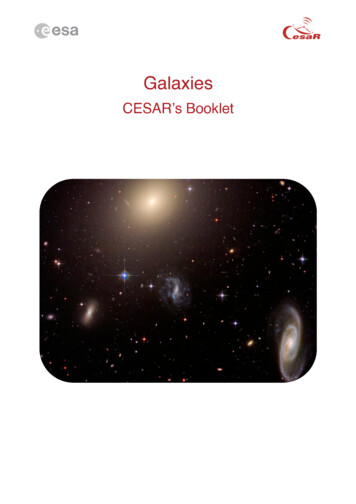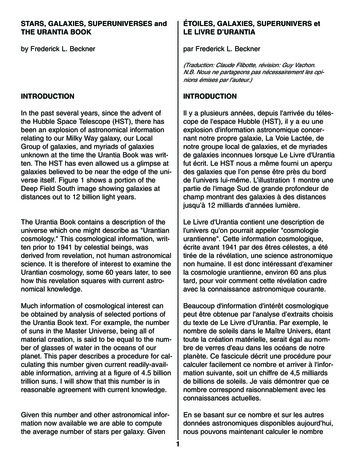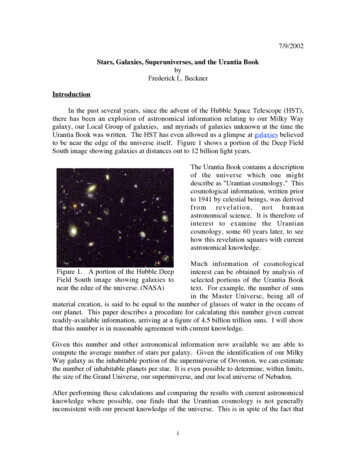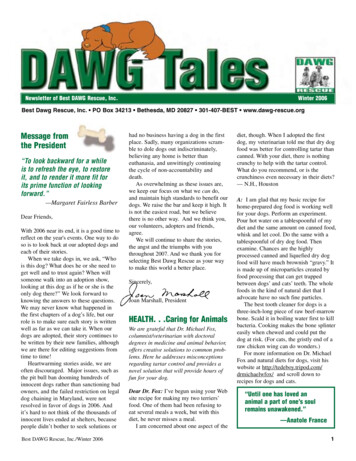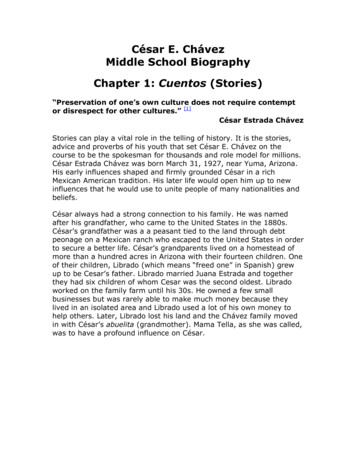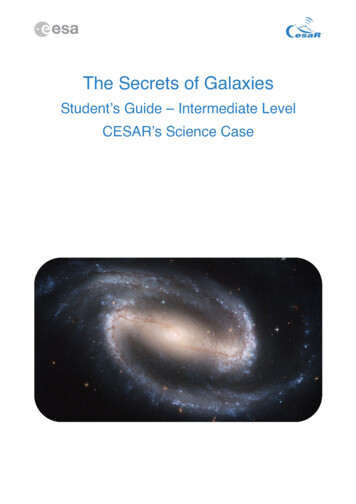
Transcription
The Secrets of GalaxiesStudent’s Guide – Intermediate LevelCESAR’s Science Case
IntroductionGalaxies are fundamental building blocks of the Universe. Some are simple, while others are verycomplex in structure; some have enormous sizes and contain trillions of stars, while others arevery small and contain only hundreds of thousands of stars; some are yellowish and other displaya variety of colours, from red to blue.In science, the first step toward understanding the properties of things is to classify them accordingto some common features. After that, scientists investigate those features in depth to figure outtheir origin. This is done with plants, animals, rocks, stars, and also with galaxies.In this activity, you will use ESASky, a portal for exploration and retrieval of space astronomicaldata, to study the properties of galaxies. You will get a list of galaxies and will have to classify themaccording to their shapes. Then, you will investigate if there is a relation between the shape of agalaxy and other properties such as its colour or content in stars and gas. You will also getintroduced to the topic of galaxy formation and evolution.Before you begin, you are encouraged to have a look at the chapter “Stellar Evolution” of theCESAR booklet, as you will have to apply some of the concepts discussed there to understand theproperties of galaxies. After doing the activity, or if your teacher tells you so, you may as well readthe “Galaxies” chapter, as the ideas that you’ll learn in this lab are extensively discussed there.MaterialWhat will you need? This student’s guideCESAR BookletComputer with web browser and internet connectionList of galaxies (.txt file)Paper and penThe secrets of galaxies – Intermediate level2CESAR’s Science Case
BackgroundOne century ago, astronomers believed that the whole Universe was comprised within the MilkyWay. There was a big controversy in the 1910s and early 1920s over whether the so-called (at thetime) ‘spiral nebulae’ (milky patches of light with a spiral shape that were seen scattered amongthe stars) were outside the Milky Way or were part of it. Until work by Edwin Hubble (1889-1953)and Milton Humason (1891-1972) in the 1920s established that each of the spiral nebulae was ahuge star system, called a galaxy. They were able to measure the distance to some of thesegalaxies, proving that the Universe was much vast than previously thought, and that our Galaxy isjust one of billions of galaxies in the Universe.In 1926, Edwin Hubble proposed a classification scheme based entirely on the visual appearanceof a galaxy on a photographic plate. His system has three basic categories: elliptical, spiral, andirregular galaxies. The elliptical and spiral galaxies are subdivided further, as illustrated in thediagram in Figure 2. This diagram is known as the ‘Hubble Tuning Fork’.Figure 1: The Hubble Tuning Fork. (Credit: NASA/ESA)Astronomers soon found out that the shape of a galaxy is related to other properties like its opticalcolour, which in turn depends on the type of stars it contains. But because galaxies are so faraway, it is not possible, in most cases, to see the individual stars that form them. What we see isThe secrets of galaxies – Intermediate level3CESAR’s Science Case
the combined light from all those stars, and essentially from the brightest and biggest stars within agalaxy –the so-called giant and supergiant stars– that are the ones responsible for the colours weobserve. Astronomers also know that blue giant stars are young, massive stars, while red giantsand supergiants are old stars approaching the end of their lives –depending on their mass, this willbe in the form of a white dwarf, or a supernova explosion leaving behind a neutron star or blackhole, as shown in Figure 2. On the other hand, young, low-mass stars –the so-called red andyellow dwarfs– are quite dim, contributing very little to the overall light emission of a galaxy.Figure 2: A star’s evolution in time depends on its mass. (Credit: Encyclopaedia Britannica)The secrets of galaxies – Intermediate level4CESAR’s Science Case
Activity ExecutionLoad ESASky in your browser by entering:http://sky.esa.intIf you had not worked with it before, take a few minutes to get familiar with the tool. You may findthe Beginners’ Guide provided with the laboratory material very useful for that.Upload the galaxy list you have been given by clicking on the Upload target list button on the leftmenu. The list of objects will be displayed as shown in Figure 3. You can move to any object in thelist by clicking on its name. Below the list, some text will appear with a brief description of theselected object (see below for a transcription of this file), and the application will automatically loadthe image of it.Figure 3: The ESASky interface with its Target List functionality. A list of galaxies is loaded, and adescription of the displayed object (which is highlighted) appears below the list. (Credit: ESA/ESDC)Your first task will be to visualise each galaxy from the list in the initial optical map (DSS-2 color),and to classify it according to the Hubble Tuning Fork (you may need to play with the zoom levelsto see the details). Is it a spiral galaxy, a barred spiral, an elliptical or an irregular galaxy?Sometimes the type of galaxy will be very evident, but others it will be less clear, and it mayhappen that your classification does not agree with the classification from another group –this islike real science. To solve this type of discrepancies, astronomers make other observations to getmore detailed views of the galaxy features, or to see how the galaxy looks like in wavelengthsother than visible, so that they can learn more about the contents and shape of the galaxy.The secrets of galaxies – Intermediate level5CESAR’s Science Case
Transcription of the .txt file NGC 2997: NGC 2997 is located approximately 25 million light-years away, in theconstellation Antlia. M101: M101, also known as the Pinwheel Galaxy, is a spiral galaxy approximately 21million light-years away in the constellation Ursa Major. M91: M91 lies approximately 63 million light-years away in the Coma Berenicesconstellation. It is part of the Virgo Cluster of galaxies. Large Magellanic Cloud (LMC): The Large Magellanic Cloud (LMC) is the largestsatellite galaxy of the Milky Way, and the fourth largest galaxy in the Local Group. At adistance of about 163,000 light-years, the LMC is the third-closest galaxy to the MilkyWay, after the Sagittarius Dwarf and the putative Canis Major Dwarf Galaxy. M87: M87, located near the center of the Virgo Cluster, is one of the most massivegalaxies in the Local Universe. NGC 4565: NGC 4565, also known as the Needle Galaxy for its narrow profile, is locatedabout 30 to 50 million light-years away, in the constellation Coma Berenices. NGC 1132: NGC 1132 is located approximately 320 light-years away, in the constellationEridanus. IC 5152: IC 5152 is a dwarf galaxy in the Local Group, the group of galaxies our MilkyWay belongs to. NGC 1300: NGC 1300 is located approximately 61 million light-years away, in theconstellation Eridanus. The galaxy is about 110,000 light-years across (about 2/3 the sizeof the Milky Way). It is a member of the Eridanus Cluster, a cluster of 200 galaxies. M60: M60, also known as NGC 4649, is located approximately 55 million light-years awayin the constellation Virgo. Together with NGC 4647, it is part of a pair of galaxies knownas Arp 116. NGC 4449: NGC 4449 is a galaxy in the constellation Canes Venatici. It is located about12 million light-years away, part of the M94 Group (the Canes Venatici I Group), a galaxygroup relatively close to the Local Group containing the Milky Way. M31: The Andromeda Galaxy, M31, is located about 2.5 million light-years (780kiloparsecs) away in the constellation Andromeda. Being approximately 220,000 lightyears across, it is the largest galaxy of the Local Group, which includes the Milky Way,the Triangulum Galaxy and about 44 other smaller galaxies.After you have discussed your classification and compared it with the rest of the groups, yourteacher will tell you the ‘official’ classification –that is, the type assigned to each galaxy byastronomers based on their current knowledge of the objects.Now that you know the type of each galaxy, go through the list again to investigate the propertiesof the different types of galaxies, using the questions in the box below as guidelines. Do you seesome relation between the shape and the colour of a galaxy? What can these colours mean, interms of the stars contained in each galaxy? If stars form from clouds of gas and dust, whichThe secrets of galaxies – Intermediate level6CESAR’s Science Case
galaxies do you think are rich in these clouds? Which galaxies are forming stars, and which arenot?The last question refers to the meaning of the Hubble Tuning Fork. For a time, this diagram wasthought to represent an evolutionary sequence, with galaxies progressing from left to right acrossthe diagram as they evolve from one type into another. Taking into account what you have learnedabout the content of the different types of galaxies, do you think this is the case?Guidelines for exploration1. Classify the galaxies in the list according to the Hubble scheme. Are they spirals, barredspirals, ellipticals or irregulars?2. Do the colours of galaxies seem related to their shapes? Explain.3. Look at the spiral galaxies. Why are the colours of the bulge (central part) and the coloursof the spiral arms so different? Suggest an explanation. (Note that only the most luminousstars are observable at these large distances.)4. Compare the bulges of spiral galaxies to elliptical galaxies. In what sense are theysimilar?5. Stars form from clouds of gas and dust that collapse due to their own gravity. After whatyou have deduced from the colours of galaxies, will you expect spiral galaxies to be rich ingas and dust? And elliptical galaxies? Where do you expect to find most of this gas and dustwithin a galaxy?6. Hubble thought that his tuning fork diagram displayed an evolutionary sequence forgalaxies. According to his hypothesis, galaxies would initially have a spherical shape, andwould flatten and develop their spiral arms with time, until they become very disrupted andirregular. Based on what you have been discussing, do you think that this hypothesis isplausible? Explain your answer.The secrets of galaxies – Intermediate level7CESAR’s Science Case
ConclusionsIn this activity, you have explored the properties of galaxies and how their shapes and content arerelated.Now summarise your conclusions: How are galaxies classified? What type of stars do the different types of galaxies contain? Which galaxies are rich in gas anddust? From what you have learned of the properties of galaxies, do you think that the Hubble TuningFork is an evolutionary sequence for galaxies?If you want to learn more, you can now research about the formation and evolution of galaxies.The secrets of galaxies – Intermediate level8CESAR’s Science Case
The secrets of galaxies – Intermediate level 3 CESAR’s Science Case Background One century ago, astronomers believed that the whole Universe was comprised within the Milky Way. There was a big controversy in the

